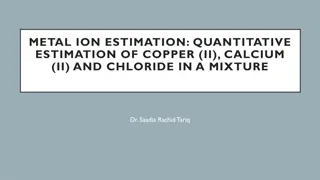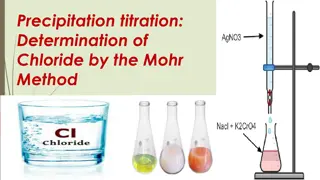Gravimetric Determination of Chloride as Silver Chloride
This experiment involves precipitating chloride ions as silver chloride by adding silver nitrate to an acidified chloride solution. The resulting silver chloride precipitate is coagulated, filtered, and weighed to determine the chloride content gravimetrically. Factors affecting the solubility of silver chloride, precautions to prevent errors, and the importance of precise handling techniques are highlighted in the procedure.
Download Presentation

Please find below an Image/Link to download the presentation.
The content on the website is provided AS IS for your information and personal use only. It may not be sold, licensed, or shared on other websites without obtaining consent from the author.If you encounter any issues during the download, it is possible that the publisher has removed the file from their server.
You are allowed to download the files provided on this website for personal or commercial use, subject to the condition that they are used lawfully. All files are the property of their respective owners.
The content on the website is provided AS IS for your information and personal use only. It may not be sold, licensed, or shared on other websites without obtaining consent from the author.
E N D
Presentation Transcript
Experiment (4). Gravimetric Determination of Chloride (Cl-) as Silver Chloride (AgCl) by Precipitation Method
The aqueous solution of the chloride is acidified with nitric acid and a slight excess of silver nitrate solution is added, whereupon silver chloride is precipitated. NaCl + AgNO3 AgCl + NaNO3 The precipitate, which is initially colloidal, is coagulated by heating the solution and stirring the suspension vigorously.
AgNO3 + NaCl NaNO3 + AgCl Precipitate
Silver chloride (AgCl) has solubility in water of 1.4mg/L at 20 C, and 21.7 mg/L at 100 C. The solubility is less in the presence of very dilute nitric acid (HNO3), and is very much less in the presence of moderate concentrations of silver nitrate (AgNO3).
Notes: 1- The sample solution was acidified in order to prevent the precipitation of other silver salt such as phosphate and carbonate, or formation of insoluble AgOH in alkaline medium.
2- The formed ppt. is sensitive to the light. 2AgCl(s) The results will be (-ve error) due to the removal of Cl- from the ppt. In the absence of excess silver nitrate (AgNO3). light 2Ag(s) + Cl2(aq) But causes (+ve error) in the presence of excess silver nitrate (AgNO3), because the chlorine (Cl2) changed back to ppt. (AgCl), which cause further precipitation of silver chloride according to this reaction: 2AgCl(s) light 2Ag(s) + Cl2(aq) 3Cl2(aq) + 3H2O + 5AgNO3 5AgCl(s) + HClO3 + 5HNO3
3- The precipitant agent was added slowly with constant stirring, to prevent local high concentration of the ppt. 4- 10% excess of the real volume of AgNO3 was added to decrease the solubility of silver chloride by common-ion effect. AgCl Ag+ + Cl- AgNO3 Ag+ + NO3- Common ion
5- When a very slight excess than 10% of silver ion was added then the solubility of silver chloride increase due to formation of the soluble complex cations: AgCl(s) + Ag+(excess) Ag2Cl+(aq) Ag2Cl+ + Ag+(excess) Ag3Cl++(aq)
6- The ppt. was washed with 0.01M HNO3 (dilute), not higher concentration because the solubility of AgCl is greater in the stronger HNO3. 7- Solubility of AgCl is increased by increasing temperature therefore it is filtered at room temperature. 8- Precipitant agent (AgNO3) is light sensitive, therefore it must be protect from the light. 2AgNO3light2Ag(s) + 2NO2 + O2
Procedure: Sample solution Weighing sample 0.1-0.15g (NaCl) Dissolving using: 1-D.W. then dilute to 100ml 2-Acidified by 2ml HNO3(1:4) -Add precipitating agent AgNO3(0.1M) + %10 excess [total = 20ml] Calculation Weighing dry AgCl - Heat near boiling for 3min. with stirring. - maintain for 5 min. H2O Drying at 130-150oC Washing using HNO3(0.01M) -Digest for about 1 hr in the dark place Pure ppt. of AgCl White ppt. of AgCl Filtration
Calculation: Wt. sample(NaCl) x [At.Wt. Cl x 1] Wt. Cl(T)= M.Wt. sample (NaCl) At.Wt. Cl Wt.Cl(P)= Wt. of ppt. (AgCl) x Gravimetric G.F. = Factor M.Wt. ppt. (AgCl) Wt.Cl(P) %Cl(P)= x 100 Wt. Sample Wt.Cl(P)- Wt.Cl(T) Wt.Cl(P) %Error = x 100 , Recovery = x 100 Wt.Cl(T) Wt.Cl(T)























